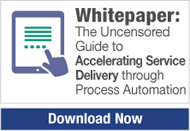The National Contract Management Association (NCMA) conducted a study on contract management efficiency. The organization interviewed over 100 companies, from a wide range of industries headquartered in both the U.S. and Europe, on their contract management process – from contract creation and visibility/access to contract commitment control/tracking and risk management. Their findings were far from positive, but provided a crucial wake-up call for organizations of all sizes and industries: Companies aren’t coming close to achieving document control efficiency via contract management best practices. 
A few of the study’s eye-opening findings:
INACCESSIBILITY
- 81% of companies surveyed said that simply finding contracts was a major concern.
- 54% found it difficult to access specific terms and clauses without scouring through contracts.
- More than half of companies said they were unable to analyze their contracts by vendor, customer, product or service line in order to achieve full negotiation leverage and/or optimize performance from a vendor or customer.
COMMITMENT MISMANAGEMENT
- At 75% of companies surveyed, managing contractual commitments – a crucial aspect of preserving business relationships and transactions among parties – was “keeping contract professionals awake at night.”
VALUE LOSS
- 40% of companies surveyed reported that they would achieve large savings in contract procurement by managing contracts better.
- 31% felt they would benefit from large, recurring revenue by managing sales contracts better.
IMPROPER RISK CONTROL
- 75% of companies listed contractual risk as a major concern.
- 61% had no idea of the interdependencies amongst their contracts.
- 66% either rarely kept track of or did not keep track of side letters at all.
- 60% did not track contingent liabilities.
- Over 50% of companies surveyed had no reliable process to alert the appropriate people to respond to triggered risks.
The reality is that businesses are increasingly relying on contracts, and these contracts are increasing in sophistication: from commitments, obligations and terms to compliance and risk factors. That’s why a contract management system is so crucial to keeping your organization on the forefront of value-enhancing, relationship-preserving and productivity-boosting contract control.
Here’s how document management software streamlines and refines the stages of contract lifecycle management (CLM):
CONTRACT REQUEST: How easy it is to request a new contract, get it in queue and route it to the appropriate people with all necessary information intact
- The Challenge: Slow cycle times push revenue into the next quarter and introduce major bottlenecks into contract procurement.
- The Solution: Contract management software that integrates seamlessly with your organization’s line-of-business (LOB) systems – i.e., the core products or services you offer – makes it easy to both initiate contracts and search for contract-related information.
CONTRACT AUTHORING: How easy it is to implement the most updated and approved contract language when composing a contract
- The Challenge: When contracts don’t use the latest, accepted jargon, enforcing standards often comes with costly and time-consuming legal review.
- The Solution: Contract management software allows you to create contracts within common word processers (e.g., Microsoft Word) with approved jargon. In other words, you’re complementing the processer’s familiar formatting capabilities (e.g., bolding, highlighting and adding headers/footers)
CONTRACT APPROVAL: How easy it is to obtain multiple approvals from different departments and functions in your organization
- The Challenge: Rule the game in contract approvals – from industry governing bodies and contract type to the dollar amount and number of contracts at play with a particular vendor.
Logically, the more complex approvals become, the longer they take. And as we stated before, contracts are becoming more and more intricate as vendors advance and take on increasingly sophisticated business models.
- The Solution: Progressive contract management software implements a dynamic approvals process based on multiple criteria. With workflow automation, you’re able to tailor both parallel and serial approval workflows to match the singularities of each contract. This eliminates bottlenecks, minimizes costly delays and, most importantly, optimizes your approval process as business conditions change without compromising document control and contract compliance.
The contract lifecycle includes a few more steps – execution, obligations management, amendments, auditing/reporting and renewals – but we’ll save those for a later blog post.
For now, we’ll leave you with seven simple best practices to complement your best-fit contract management system and further optimize your CLM:
- Eliminate reviewers who don’t add value.
- Keep all of your documents in one electronic repository.
- Stop printing, emailing or using couriers!
- Use version control so you obliterate confusion about which is the right and most recent document to be working on.
- Make template documents and make them easily accessible for anyone submitting contracts.
- Provide training to your end users on contract writing and reviewing. This makes the review process much smoother by eliminating those time-wasting clauses that are never going to get approved.
- Get your partners and subcontractors on board with electronic signatures.
The next step after contract management automation is process improvement. Click the button below to download our complimentary report: Accelerating your Service Delivery through Process Automation.

